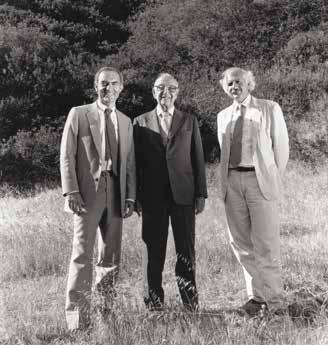
4 minute read
A Solid Foundation
A SOLID

FOUNDATION
The Skirball’s architect, Moshe Safdie, reflects on conceiving and creating a “belonging building.”
In honor of the Skirball’s twenty-fifth anniversary, President and CEO Jessie Kornberg met with Moshe Safdie— the world-renowned architect who designed all four construction phases of the Skirball’s fifteen-acre campus—to unearth stories of how the institution came to be a place of welcome. Looking back to the Skirball’s origins, Safdie recalled moments of inspiration and appreciation for the ways in which founder Uri Herscher’s ambitious dreams have been realized. Excerpts of their illuminating conversation are presented here.
JESSIE KORNBERGIt’s meaningful that you are honored on the wall at the entrance to the Founders Courtyard. It’s a reflection of the extent to which Uri, in particular, and all of us feel your guiding influence. When you think of the Skirball, what’s your earliest memory?
MOSHE SAFDIE I remember coming to Hebrew Union College at the University of Southern California to meet with Uri, whom I’d met in Jerusalem. There was a little Skirball Museum in the basement. And Uri said, “We’re thinking of building a museum. We have a site. But the board wants a California architect.” I suggested one and told Uri I’d keep an eye on the project as a consultant. But there were tensions with whom they chose. At some point, Uri said to me, “Why don’t you take over?” I refused because the architect was an old friend. But time went by, and the project wasn’t progressing. I spoke to the architect, and he generously encouraged me to take over.
JK Two things about the Skirball echo in this story. The first is something Uri always says: “Relationships, relationships, relationships.” It’s what we’re built on. The second, also impressed upon me by Uri, is that you’re unlikely to get something important right on the first try, and that experimentation and recalibration are okay. The campus itself seems to evolve over the four phases of its construction. What were the things that you learned that you were able to incorporate as you embarked on the new phases?
MS I was able to understand how the building was being used. Also, in terms of the design, it became fun to do variations on a theme, like a composer who has a series of movements. And I think the richness of the architecture has a lot to do with the sequences in which we built it. There’s a progression. The rooms are so different, and each courtyard has its own very particular personality. I think the Skirball is the most musical of my buildings.
JKWhen we think of variations on themes at the Skirball, of course, the strongest themes are Jewish. The most literal Jewish story in the design, I think, is how our entrance evokes a sukkah. Do you have places on the campus where you see Jewish themes come through particularly well? MS The idea that the entrance is a sukkah is right on. My hope was that you wouldn’t quite be sure whether you’re inside or outside. The key to the experience of the Skirball is that you’re inside even when you’re outside, and you’re outside even when you’re within the building. You’re always conscious of the gardens and the landscape. And then when you’re in the courtyards, you are still in the Skirball—the institution’s activities are going on around you. It’s Jewish in a subtle way.
JK It’s a desert climate, and we’re a desert people. It’s architecture that reflects the place in which it is sited. Our core exhibition, Visions and Values, talks about Jewish culture through the diaspora. In a healthy, liberal society, they become intertwined and inextricable from one another. We are always American, we are always Jewish, and you cannot take the two apart. We are always in, and we are always out.
MSIn terms of this being a Jewish institution in America, I’d go further and say it’s a Jewish institution in America in the state of California. The building is quintessentially Californian. And in that sense, it’s very much a belonging building.
JKOne thing that is so wonderful is that you come back and visit regularly. Do you have a particular memory here that stands out to you?
MS There are many moments. I remember the extraordinary resolutions to crises that showed our resilience. I also think of first seeing kids walk into Noah’s Ark when it opened. And the first time I saw Ned Kahn’s rainbow sculpture creating a real rainbow. And the kids seeing it too. That was a wonderful moment. I recall a great, festive dinner in Ahmanson Hall when I suddenly realized that the Skirball was an established institution, not a startup anymore. Finally, I think about when we opened Herscher Hall and revealed the sunken garden. It was a big triumph to see it growing beautifully.
JKFrom the first night to this morning, it is breathtaking.
MS To me, the big miracle of the Skirball has been the programming that has evolved over the years. The life in this place is the pleasure and surprise.
This interview has been condensed and edited for clarity and length.
Facing page, top and bottom: Photographed here in 1985, Uri Herscher, Jack Skirball, and Moshe Safdie stand on the site where the Skirball Cultural Center would be built. In 2013, Safdie attended the opening of the exhibition Global Citizen: The Architecture of Moshe Safdie, which surveyed his celebrated works around the world including the Skirball.









